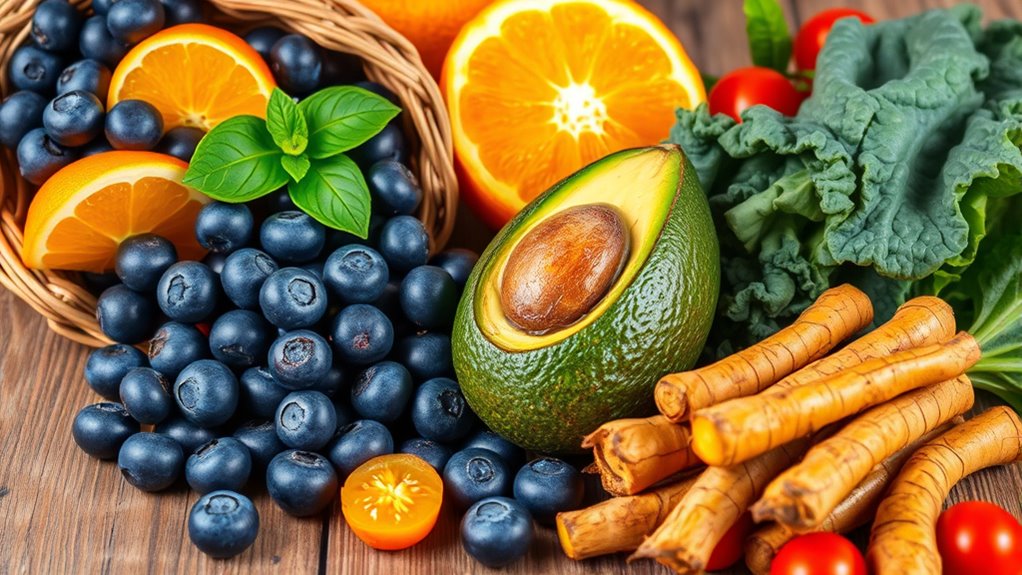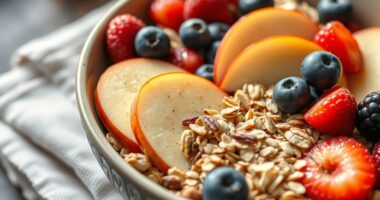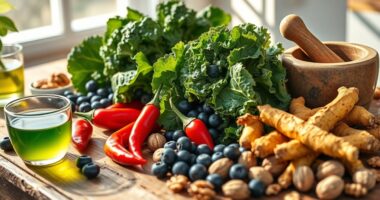To fight midlife inflammation, focus on eating whole grains like oats, brown rice, and rye, which lower inflammatory markers. Incorporate nuts and seeds such as almonds, walnuts, and flaxseeds for their healthy fats. Boost your intake of colorful fruits and vegetables like berries, leafy greens, and tomatoes to provide powerful antioxidants. Include fatty fish like salmon and mackerel for omega-3s, and sip green tea or turmeric-spiced drinks to enhance anti-inflammatory benefits. Keep exploring to discover more ways to lower inflammation naturally.
Key Takeaways
- Incorporate whole grains like oats, brown rice, and rye to reduce inflammatory markers and support gut health.
- Eat a variety of nuts and seeds such as almonds, walnuts, and chia for their anti-inflammatory unsaturated fats.
- Consume abundant fruits and vegetables, especially berries, leafy greens, and tomatoes, rich in antioxidants and polyphenols.
- Include fatty fish like salmon, mackerel, and sardines for omega-3s that lower systemic inflammation.
- Use anti-inflammatory spices and beverages like turmeric, ginger, green tea, and citrus fruits to boost immune health.
Embracing Whole Grains and Fiber-Rich Foods
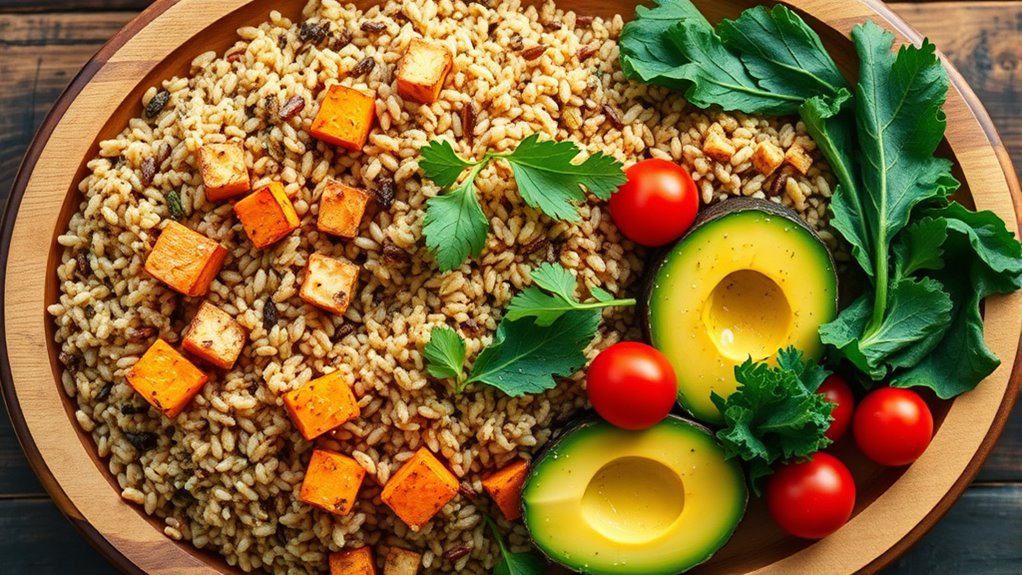
Eating more whole grains and fiber-rich foods can considerably help reduce inflammation as you age. Numerous studies show that whole grain consumption lowers inflammatory markers like C-reactive protein (CRP) and Interleukin-6 (IL-6), which are linked to chronic diseases. When you include whole grains like oats, barley, and brown rice in your diet, you promote systemic health by decreasing overall inflammation. High fiber intake from these foods supports gut health and helps regulate immune responses. Specific grains, such as rye and rye bran, have shown to lower inflammation markers like TNF receptor-2 and E-selectin. By making whole grains a regular part of your meals, you not only improve nutrient intake—vitamins, minerals, antioxidants—but also take a crucial step toward reducing inflammation and boosting overall health as you age.
Incorporating Nuts and Seeds for Inflammation Reduction
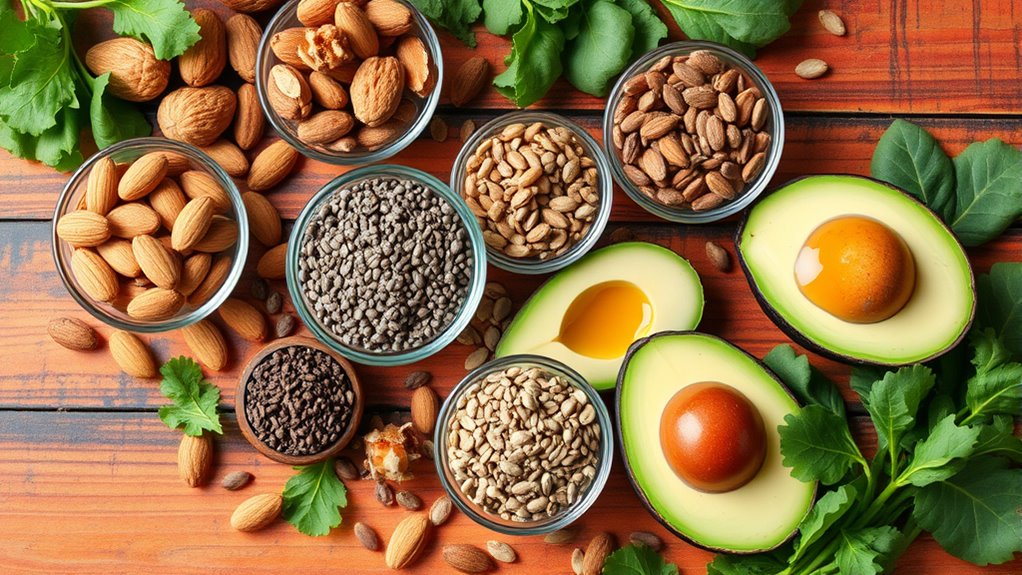
Incorporating nuts and seeds into your diet can be a simple yet effective way to combat inflammation as you age. They are rich in unsaturated fats that help lower inflammation and antioxidant compounds that reduce oxidative stress. Regular nut consumption has been linked to lower CRP and IL-6 levels, markers of inflammation, and can improve your endothelial function. Nuts like almonds, walnuts, Brazil nuts, pistachios, and hazelnuts offer unique benefits, and including them as snacks or part of meals boosts your intake. Just remember to enjoy them in moderation to balance calories and fats. Proper portion control is essential to avoid excessive calorie intake while reaping their health benefits. Combining nuts and seeds with other anti-inflammatory foods enhances their effects, making them a versatile addition to your health-focused diet. Understanding the Law of Attraction principles can also motivate you to adopt healthier eating habits that support overall well-being.
Boosting Intake of Fruits and Vegetables

To effectively reduce inflammation, increasing your intake of fruits and vegetables is essential because they are packed with antioxidants and bioactive compounds that support immune health. Fruits like berries, cherries, and apples contain polyphenols and flavonoids that combat inflammation, while vegetables such as leafy greens and tomatoes provide vitamins, minerals, and lycopene, an antioxidant that lowers inflammatory markers. Consuming a variety of colorful produce boosts your immune response by increasing γδ-T cells and reducing pro-inflammatory genes. The fiber in fruits and vegetables also promotes gut health, indirectly reducing systemic inflammation. Incorporating these foods regularly, especially within a Mediterranean-style diet, can profoundly lower inflammation levels, improve overall health, and reduce chronic disease risk associated with midlife inflammation. Additionally, evidence suggests that a diverse intake of plant foods can help break patterns of behavior that contribute to ongoing inflammation. Moreover, understanding the role of antioxidants found in these foods can further enhance their anti-inflammatory effects.
Leveraging Fatty Fish and Seafood Benefits
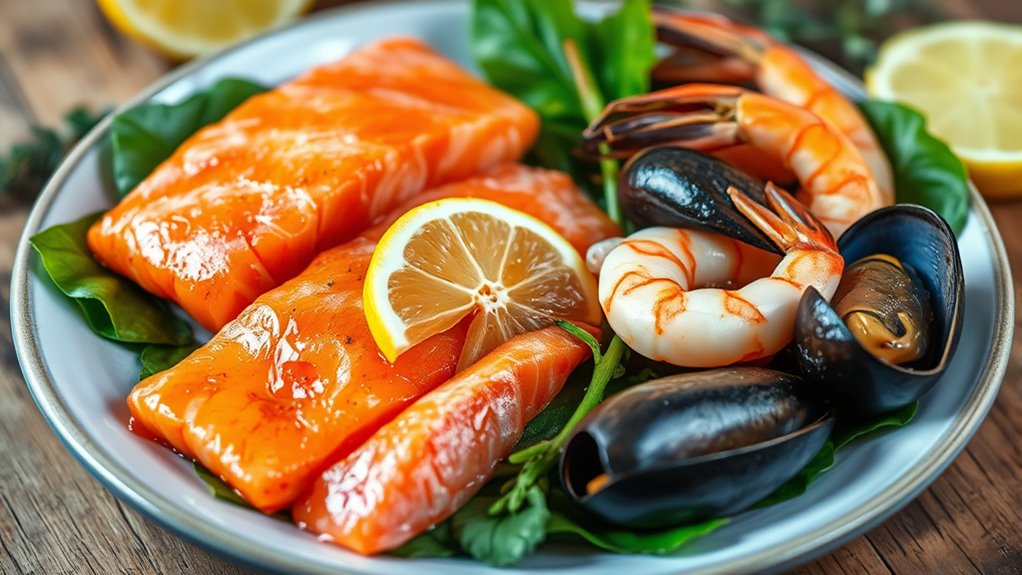
Fatty fish and seafood are among the most effective foods for reducing inflammation, thanks to their high levels of omega-3 fatty acids. These long-chain omega-3s, especially EPA and DHA, lower markers of subclinical inflammation like hs-CRP and cytokines such as IL-6 and TNF-α. They help modulate immune responses, decrease inflammatory markers damaging blood vessels, and boost specialized pro-resolving mediators (SPMs) that resolve inflammation. Eating fatty fish regularly supports better lipid and glucose metabolism, reduces inflammatory growth factors, and improves vascular health. Unlike supplements, consuming whole fish offers additional nutrients like vitamin D and selenium, which enhance anti-inflammatory effects. Top sources include salmon, mackerel, sardines, and anchovies, making them powerful allies against midlife inflammation. Incorporating Vetted electric bike conversion kits can encourage more active lifestyles, further aiding in inflammation reduction.
Using Anti-Inflammatory Beverages and Spices

Adding anti-inflammatory beverages and spices to your daily routine can considerably help reduce midlife inflammation. Start your day with green tea, which contains EGCG, an antioxidant with anti-inflammatory effects. Swap out coffee for a cup of herbal ginger or peppermint tea to gain additional benefits. Incorporate turmeric into your drinks or smoothies for its powerful curcumin content, known to fight inflammation. Oranges and 100% juices provide vitamin C, helping to lower inflammation markers like interleukin 6. Use spices like ginger, cinnamon, cayenne, and saffron in cooking or teas to enhance anti-inflammatory effects. These simple swaps and additions support your body’s fight against inflammation, improve overall health, and promote better aging. Including a variety of anti-inflammatory ingredients can optimize your health benefits. Consistently including these beverages and spices can make a meaningful difference in midlife wellness. Natural remedies such as these are often easier to incorporate into daily routines than more invasive approaches. Incorporating methods like brewing techniques can help you enjoy these ingredients in the most effective way. Additionally, choosing products with proven anti-inflammatory properties, such as those found in certain foods and supplements, can further enhance your efforts. Moreover, AI-driven health insights are increasingly helping individuals personalize their anti-inflammatory strategies, making these efforts more targeted and effective.
Frequently Asked Questions
How Do Specific Foods Influence Hormonal Balance During Midlife?
You can influence your hormonal balance during midlife by choosing foods that support your body’s natural processes. Phytoestrogen-rich options like soy and flax seeds help manage menopausal symptoms, while leafy greens and cruciferous vegetables promote detoxification and hormone regulation. Incorporate nuts, seeds, legumes, and healthy fats to stabilize hormones, reduce inflammation, and support overall balance. These foods work together to maintain your health as you navigate midlife changes.
Can Diet Alone Significantly Reduce Systemic Low-Grade Inflammation?
Did you know that adopting an anti-inflammatory diet can lower your CRP levels by up to 30%? While diet alone isn’t a cure-all, it plays a vital role in reducing systemic low-grade inflammation. You can considerably impact your health by choosing foods like fatty fish, leafy greens, and berries. Combined with lifestyle changes, a targeted diet can help manage inflammation, improving your overall wellbeing during midlife.
What Are the Best Strategies to Incorporate These Foods Into Daily Meals?
You can easily incorporate anti-inflammatory foods into your daily meals by planning ahead and using simple techniques. Include fatty fish like salmon twice a week, add colorful fruits and vegetables to every plate, and snack on nuts or seeds. Use herbs like turmeric and ginger in cooking, swap refined grains for whole grains, and choose healthy fats like olive oil. Preparing batch meals and keeping pre-cut veggies handy make it convenient to stay consistent.
Are There Any Risks Associated With High Consumption of Anti-Inflammatory Foods?
You might worry about risks from eating too many anti-inflammatory foods, but with balance, you’ll be safe. Overdoing it can lead to nutrient overloads like excess vitamins, mineral imbalances, or digestive issues. To enjoy their benefits without harm, monitor portion sizes, diversify your choices, and consult with a healthcare professional if needed. This way, you get the health perks while avoiding potential downsides.
How Quickly Can Dietary Changes Impact Inflammation Markers in Midlife?
You might see changes in inflammation markers within a few weeks after adjusting your diet. Some studies show rapid reductions in biomarkers like CRP and IL-6 with dietary modifications. However, the exact timing varies depending on your baseline health, lifestyle, and how consistent you are with these changes. Staying committed and combining diet with other healthy habits can lead to more significant, sustained improvements over time.
Conclusion
As you explore these anti-inflammatory foods, you might notice how small changes fit seamlessly into your routine—like choosing whole grains or adding a handful of nuts. Sometimes, it feels like the universe aligns to guide you toward healthier choices, turning everyday meals into powerful allies against inflammation. Embrace these foods, and you could find yourself feeling more energized and balanced—almost as if the right ingredients were waiting just for you all along.
